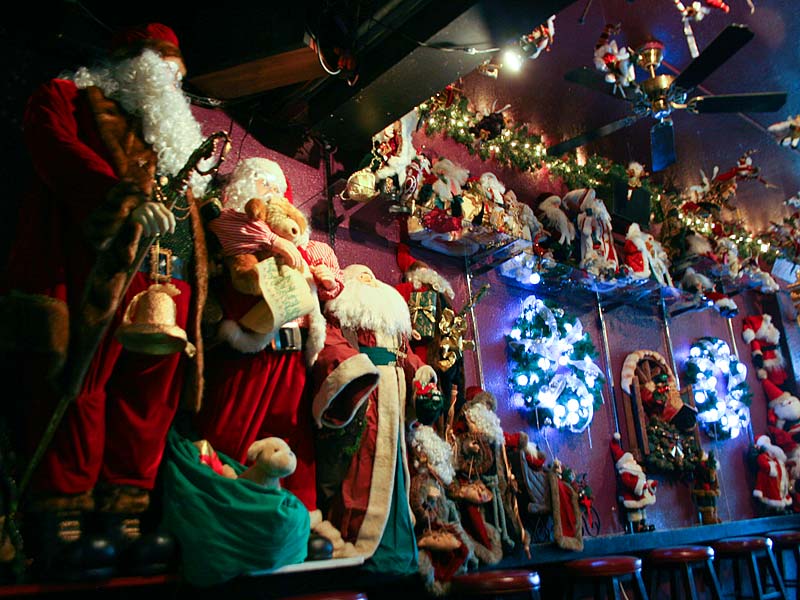There was no such thing as a normal night at Marlena’s. Certainly not around Christmastime. If you walked in on a Saturday night in December, you’d probably see drag queens gyrating on a rickety makeshift stage plopped on a pool table as they belted Judy Garland songs. You’d also witness a diverse assortment of patrons guzzling vodka-crans, baby queers who’d just moved to San Francisco rubbing shoulders with older folks who’d lived in the city for decades.
Oh, yeah—you’d certainly see the rows of Santa figurines lining the walls. They were pretty hard to miss. There were more than a thousand St. Nicholas dolls, running the gamut from life-size to Lilliputian, hovering over you as though you’d stepped into a gayer, slightly unsettling version of Santa’s workshop.
Videos by VICE
Marlena’s, a bar nestled in San Francisco’s Hayes Valley, was once a hamlet for San Francisco’s ever-expanding, diverse queer community.
READ MORE: The Drag Queen Who Accidentally Broke the Internet Slays at Brunch
Emerging from the rubble of the Loma Prieta Earthquake in 1989, it established itself as a queer oasis for Hayes Valley, a now-gentrified neighborhood that had historically been devoid of dedicated public spaces for queer people. Its owner was a divorcé named Gary McLain, a man who had two grown children. McLain, now 78, began dressing as Marlena one Fourth of July 40 years ago. And it was Marlena who truly owned the bar, one that became the most Christmassy drag bar—or the draggiest Christmas bar—in San Francisco, and perhaps the world.
The faces of frequent patrons may have disappeared, either to other bars, other neighborhoods, or other cities, as many San Francisco residents have due to inflated costs of living. Maybe they’ve died. But San Francisco still thinks about Marlena’s.
In its 23 years in Hayes Valley, Marlena’s stood defiant, a welcoming den of kitsch and flamboyance in a shapeshifting city. The neighborhood changed, but Marlena’s barely did. The space occupied the ground floor of 488 Hayes Street, where it became a refuge from the despair and hopelessness of the AIDS crisis at its nadir, until Marlena sold the bar in 2013.
The bar may have closed its doors, and the community it fostered may now have dispersed. The 1,000 (or as many as 1,400, depending on who you ask) Santa figurines no longer have one central home each Christmas. The faces of frequent patrons may have disappeared, either to other bars, other neighborhoods, or other cities, as many San Francisco residents have due to inflated costs of living. Maybe they’ve died. But San Francisco still thinks about Marlena’s.
Marlena still lives above the bar. It’s hard to forget what made this place so special, and what the surrounding city has lost in its absence. Everyone has a story about Marlena’s. These are the people who are still around to tell it.
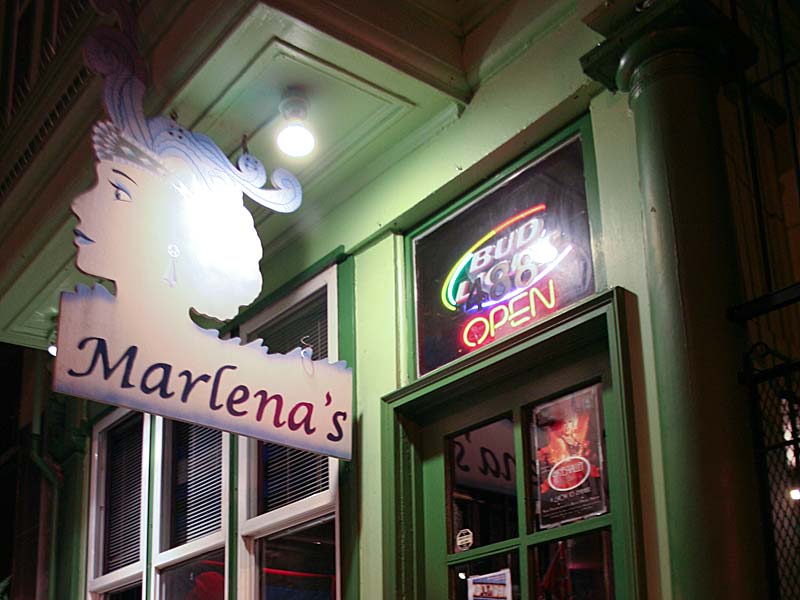
Gary McLain, a.k.a. Marlena (former co-owner of Marlena’s): I bought the bar in 1990, just after the Loma Prieta Earthquake. I’d been working at Carnation Cruises for 26 years when I met my business partner, Janice Buxton, who talked me into buying this bar she owned. The bar was called The Overpass* before I bought my stake in it, which was one-third. Janice owned the rest.
Marlena was my drag name. During my first year, I was the reigning Empress of the Imperial Court of San Francisco. That naturally brought a lot of people into the bar. About six months into owning [The Overpass], all these people were coming and calling it Marlena’s. So we decided to call it Marlena’s.
*Editor’s note: The Overpass referred to the Central Freeway, an overpass that once presided over Hayes Valley but was significantly damaged by the Loma Prieta earthquake and demolished for good in 1992, speeding up the neighborhood’s gentrification.
David Lassman, a.k.a. Chablis (Absolute Empress XXXVI of San Francisco, Stage Manager of Marlena’s): Marlena’s was the hub of the Imperial Court, basically. The Imperial Court was founded by Jose Sarria in 1965. He was the first openly gay man to run for public office, even before Harvey Milk.
The Imperial Court system is the oldest gay fundraising organization in the world, and, every year, the public elects an Emperor and Empress. I was Empress in 2001. The year that you’re elected, you’re the face of the Imperial Council.
The first time I went to Marlena’s, though, was way before—around 1995, maybe? I met Marlena as Gary first. The first thing Gary did when he saw me was ask to see my genitals. So I showed him my genitals.
It got me a free drink. There’s a lot of raunchiness in San Francisco.
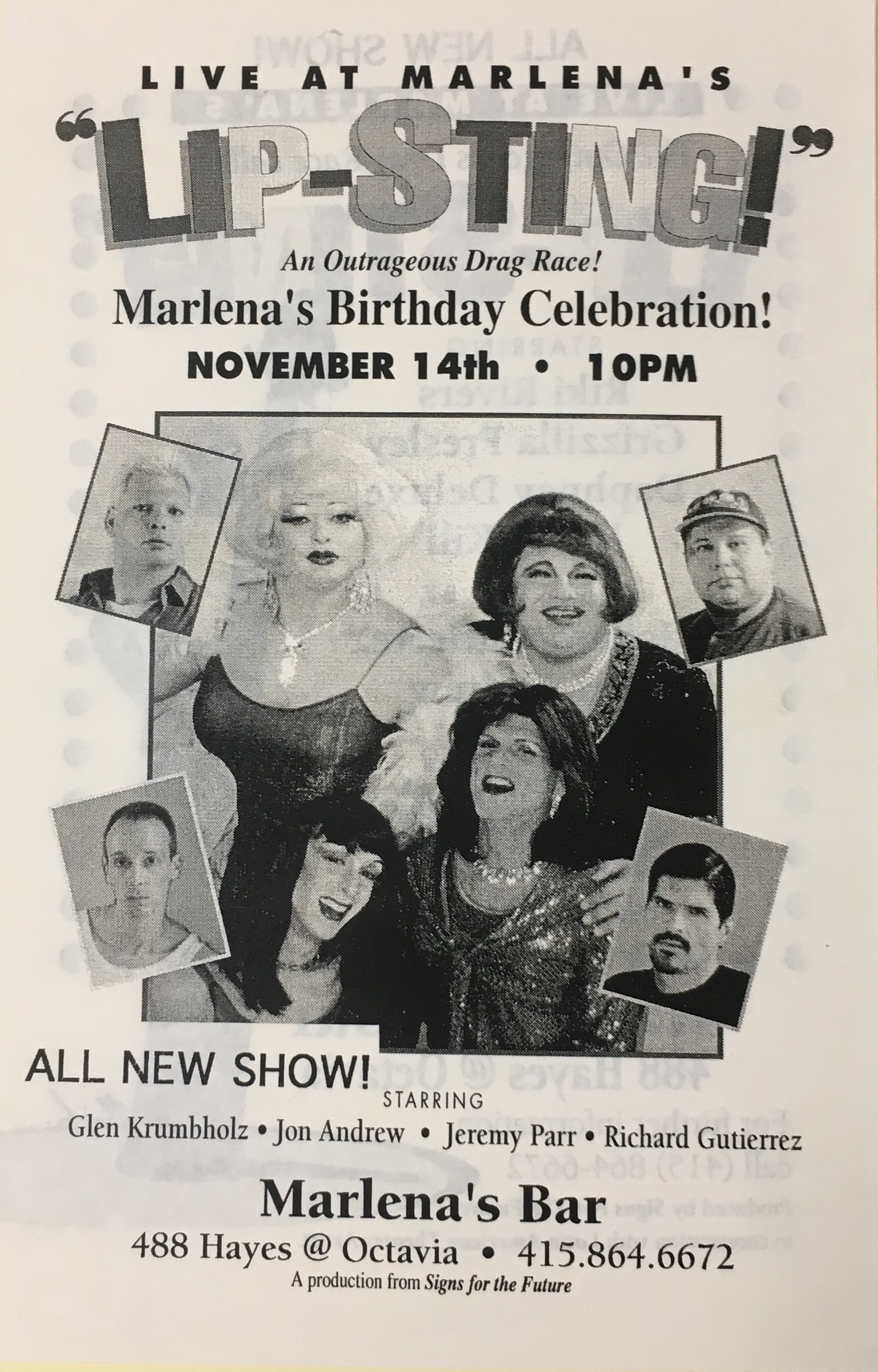
Darwin Bell (former regular at Marlena’s): I went there the most in the late 90s and early aughts, because I had a bunch of friends who were in the Imperial Court. Marlena’s was kind of a de facto gathering place for that whole scene. Everybody felt very comfortable there; there was a very strong sense of community. It was kind of a place where people could go and be themselves—which sometimes meant being really bitchy.
The bartenders there were really mean, in a fun way. They took their time with your orders. You just expected there to be really slow service and to be insulted in some way. Which was fine back then! It was funny and clever and witty.
Kris Lippincott, a.k.a. Galilea (Absolute Empress XLI of San Francisco): I joined Marlena’s as a performer in 2002. I came from Esta Noche, a Latin gay bar, where I’d been a performer. I hadn’t been to Marlena’s before I started performing there. I was a Mission girl; I never knew what the other side of town looked like.
“The first thing Gary did when he saw me was ask to see my genitals. So I showed him my genitals.”
Chablis: The neighborhood was different then. It was seedier.
Marke Bieschke (owner, The Stud): The first place I lived in 1994 when I moved to San Francisco from Detroit was four blocks from Marlena’s. This was a time in San Francisco history when there were a lot of changes happening: It was during the first web boom. The gay bar culture was coagulating around three different spots: the Castro, Polk Street, and Soma. Marlena’s being in Hayes Valley felt like such an outlier.
Jonathan Kauffman (food reporter, San Francisco Chronicle): When the freeway was still up, it cast this huge physical and psychic shadow over Hayes Valley. It was much poorer.

Ben Ospital (former regular at Marlena’s): Hayes Valley once had a reputation as a rough-and-tumble neighborhood. But it always had this nice patina of being the place where interesting, good, local things started.
Bieschke: I moved here five years after the earthquake, when Hayes Valley had already become this precious boutique neighborhood. The surrounding area didn’t follow the typical gentrification pattern where people moved in and then commercial came along. Commercial just plopped down and then that radiated outwards. There was already a cluster of boutique stores, which lent it the population that could support a gay bar.
Hayes Valley originally had a large poor, black population. It’s really only been in the past ten years that the neighborhood has switched over to a mostly white, high-earning class of tech- and design-derived professionals. When I was there, there were still women working the corner and drug dealings going on. But there was a wonderful community of people of color back then. Now it’s almost completely gone.
Bell: It was so dangerous back then. When we walked to Marlena’s from my apartment a few blocks away, we would always go in a pack of people because it was dangerous.
Chablis: No matter whether it was Friday, Saturday, or Sunday, Marlena’s was the place to be. Every Saturday night, [Marlena] had drag shows. I was the stage manager of that for years. Everybody was comfortable at Marlena’s. It was very open there.

Ospital: Marlena’s was the United Nations of ages and ethnicities. It really represented what I think was probably the city’s vast spectrum of queer culture. The beauty of the bar was always that gay or straight, or whatever your perspective happened to be, it was a good place to cool your jets. It just depended on what you need the bar for. Marlena’s functioned in so many different ways for so many different people. I mean, I met my partner at Marlena’s six years ago. I have a deep association with that place.
Marcia Gagliardi (founder and editor, Tablehopper): Whether you were gay or straight, you were welcome there, and they’d cheers you with Marlena’s infamously enormous mugs of booze.
Marlena: For our Saturday night shows, we had a stage on the wall and we’d just fold it down right on top of the pool table. You could fit ten people on stage at one time. The bar fit 100 people in there. It could get crowded. I had five bartenders and two or three barbacks, a soundman, and an official emcee. All the performers got paid.
Galilea: On Saturdays, we’d all get dressed downstairs, bar hop, and then come back and get ready for our show. I had over 500 gowns in my own dressing room. I got anything I wanted.
The bar would be kind of empty and desolate around 9 or 9:30 PM. By 10:30, though, the bar was packed. The show was full every week. I had six girls every Saturday night performing with me.
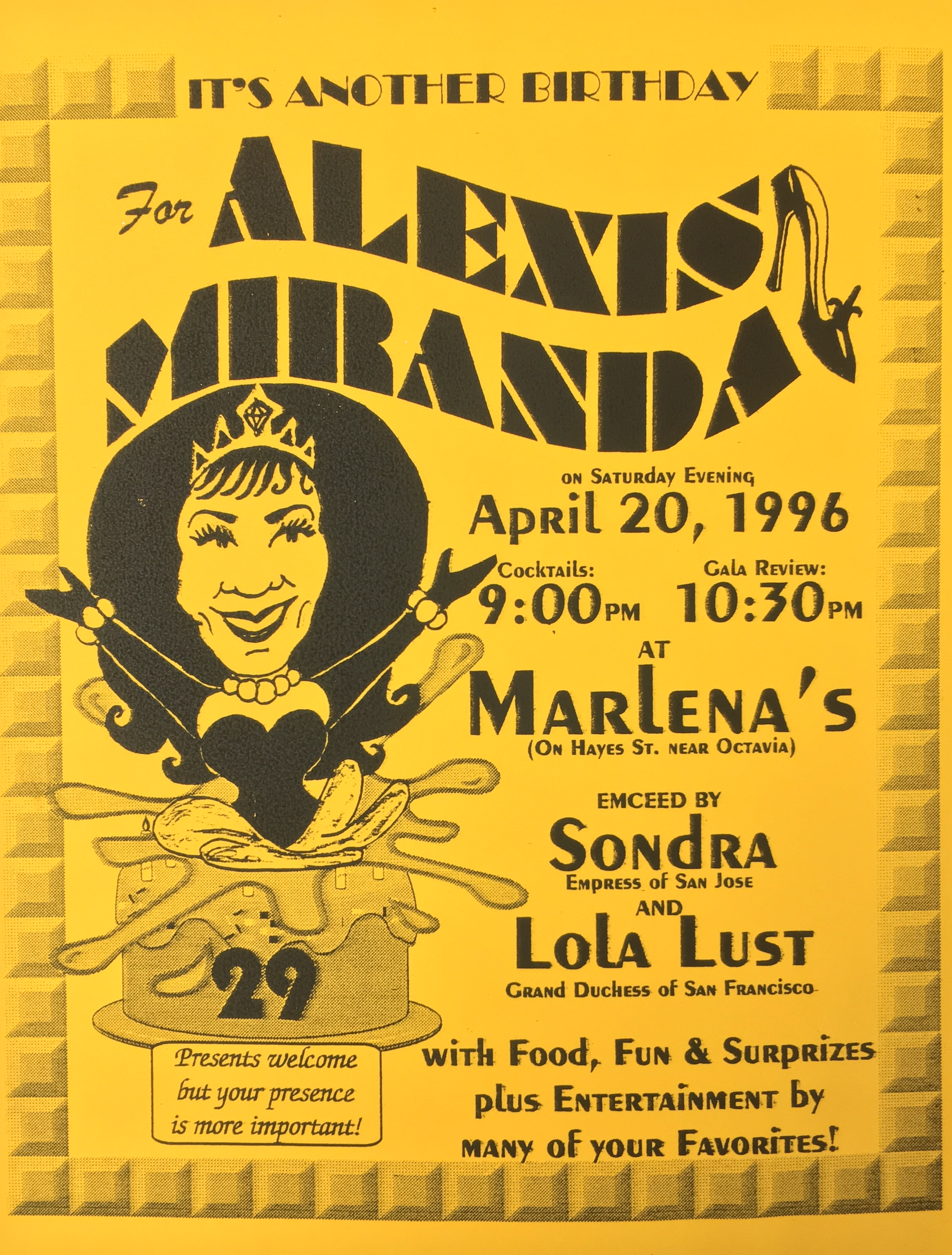
Galilea: You really never knew what was gonna happen those nights at Marlena’s, either.
Chablis: There were bartenders who, when the doors closed, did coke and would have sex on the bar. But that could be any bar in San Francisco, really.
Bell: There was one time when the stage kind of gave way a little, and one of the queens fell onto the audience. The audience caught her—it was kind of a stage dive, just not planned. The whole time, though, she kept performing.
Kauffman: Back in the 90s and early aughts, there were two different drag scenes. One was the Trannyshack drag scene. That came out of the queer punk scene, so a lot of the performances were connected to indie rock or electronic rock. Bjork and Bowie were the two polestars to that scene.
Then there were more traditional drag bars that tended to be a little more working-class. Marlena’s was one of those. That was where the queens were more likely to be, the ones in sequins who did a spectrum of songs from Cher to Rihanna.
“Come [the holiday season], though, there wasn’t a space of wall that you could see. There were so many Santas.”
Bell: Marlena’s was the first place I was exposed to older drag queens. Trannyshack skewed younger. It was alternative, fucked up, crazy drag. Marlena’s drag was traditional, Whitney Houston-type drag.
Chablis: Marlena was a grande dame. She was an older drag queen, so she didn’t look like anything like the RuPaul girls. Her gowns were more matronly. Whenever Marlena was in drag, she was the madam of the house. Very elegant and beautiful. She was the grand hostess, the life of the party.
Bell: Her decor was over the top year-round. When it wasn’t Christmas time, it was kind of a museum of Marlena’s tchotchkes and Imperial Court history.
Come [the holiday season], though, there wasn’t a space of wall that you could see. There were so many Santas.
READ MORE: Drag Queens Review the Burgers Named After Them
Gagliardi: There was no place better to start a night of holiday cheer than Marlena’s. It was the most densely packed Santa experience—wall-to-wall Santas, from creepy ones to quirky 60s ones to old school Saint Nicholas to international Santas. Every corner, stuffed with Santa, Santas in display cases, and there were even Santas suspended from the ceiling. It was impossible to not be charmed by it all, even for the holiday haters. Santa could not be denied.
Galilea: People would come in and see all her Santa Clauses. The bar was seriously decked out to the hilt.
Bieschke: The first time I really walked in was during the Christmas season. Marlena became famous for having 1,400 Santas or some insane number like that.
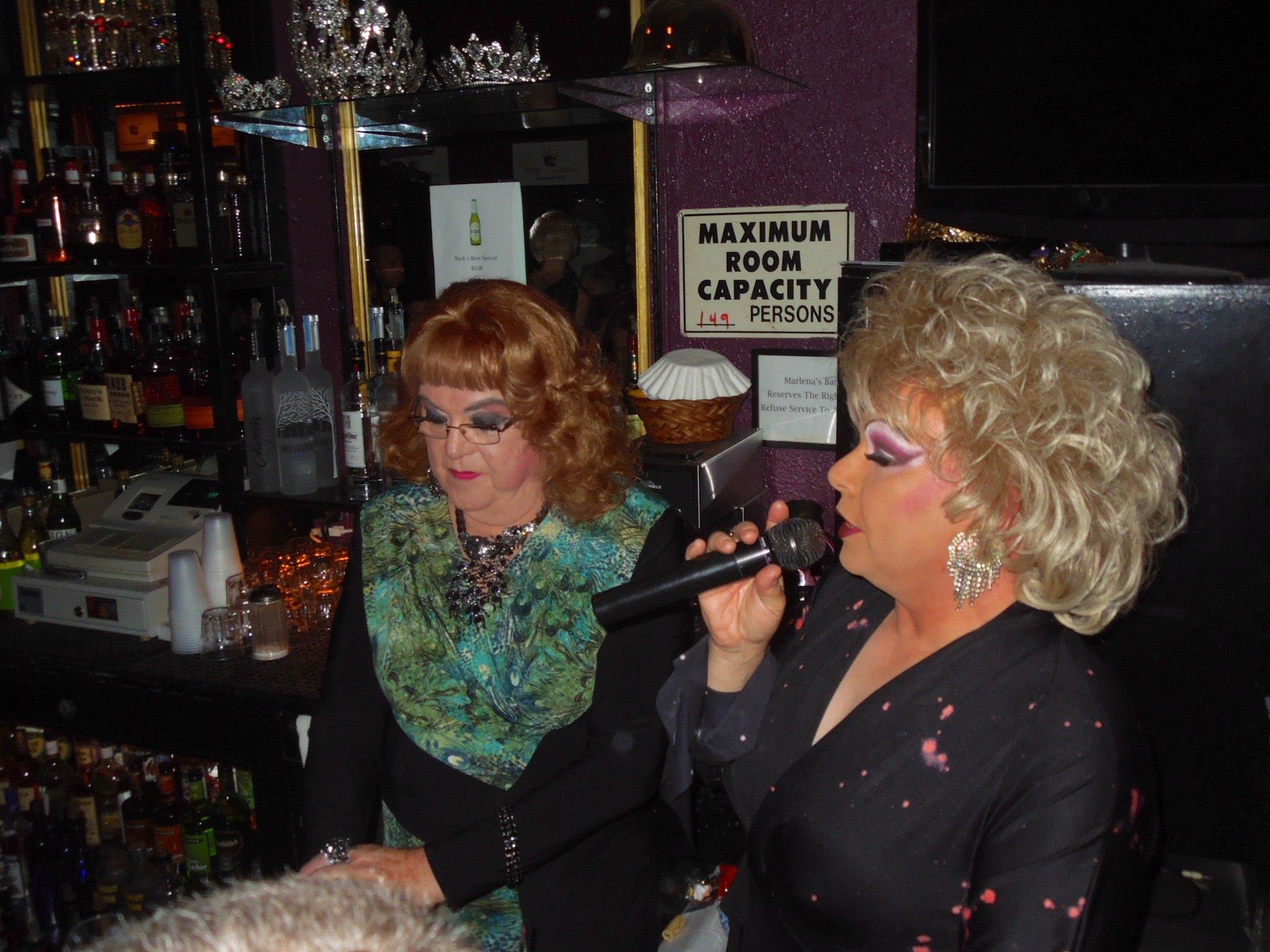
Marlena: We ended up with around 1,000 Santa Clauses in there. They came from all over the world. Most of them were gifts.
I started off with three Santas. I put them in the bar and people told me they were pretty cute . Eventually, I got acquainted with a guy who had an outlet in Sausalito for Santa Claus [dolls]. I’d go there and buy two or three. Next thing you know… well, I got a little carried away. No doubt about it. I would buy a bunch of Santas from all over the world and just ship them home. Some I found on my travels. When I was in China, I went to a factory there. When I was in Prague, I went to a factory there that made Russian Santa Clauses. We had them all.
“It never struck me as religious. It was kind of a way of reconnecting to the feeling the joy and family that was so rare to the bar, especially in the height of the AIDS days in the late 90s and early 2000s.”
Chablis: She collected the Santas over the years. She had some that were life-size to the ceiling and others that were smaller. They would hang a glass shelf behind the bar and glass shelves around the bar so they were all displayed around there. It was basically all Santas. The decorations usually went up just after Thanksgiving, around early December. The Santas stayed up through New Year’s.
Bieschke: I just remember being super taken aback by everything about the place during Christmas. It felt like I had walked into this gingerbread candy house full of leathermen and drag queens who could drink me under the table.

Galilea: Christmastime was probably the hardest time [there] as a performer. You had to compete against 1,000 Santa Clauses. No other drag queen in the world would have to compete against that!
Bieschke: People could buy into the fun Santa routine. It never struck me as religious. It was kind of a way of reconnecting to the feeling the joy and family that was so rare to the bar, especially in the height of the AIDS days in the late 90s and early 2000s. It became a place I wanted to go because it reinforced a feeling of togetherness and joy during the AIDS years.
Marlena: We gave many, many, many, many, many thousands of dollars away over the years because of the AIDS crisis. And the AIDS crisis is not over yet, let me tell you.
Chablis: I think Marlena sold all the Santas after she closed down the bar. Or maybe she has them in storage somewhere.
Marlena: The bar there today, Brass Tacks, still has two-thirds of them. The rest of them are in my hallway.
Kauffman: There’s no way to recreate that immersive atmosphere that was one part creepy, three parts fantastical, one part camp. It was camp in its excess. Even hardcore Christmas haters, which I kind of border on [myself], just wanted to be at Marlena’s during Christmastime.
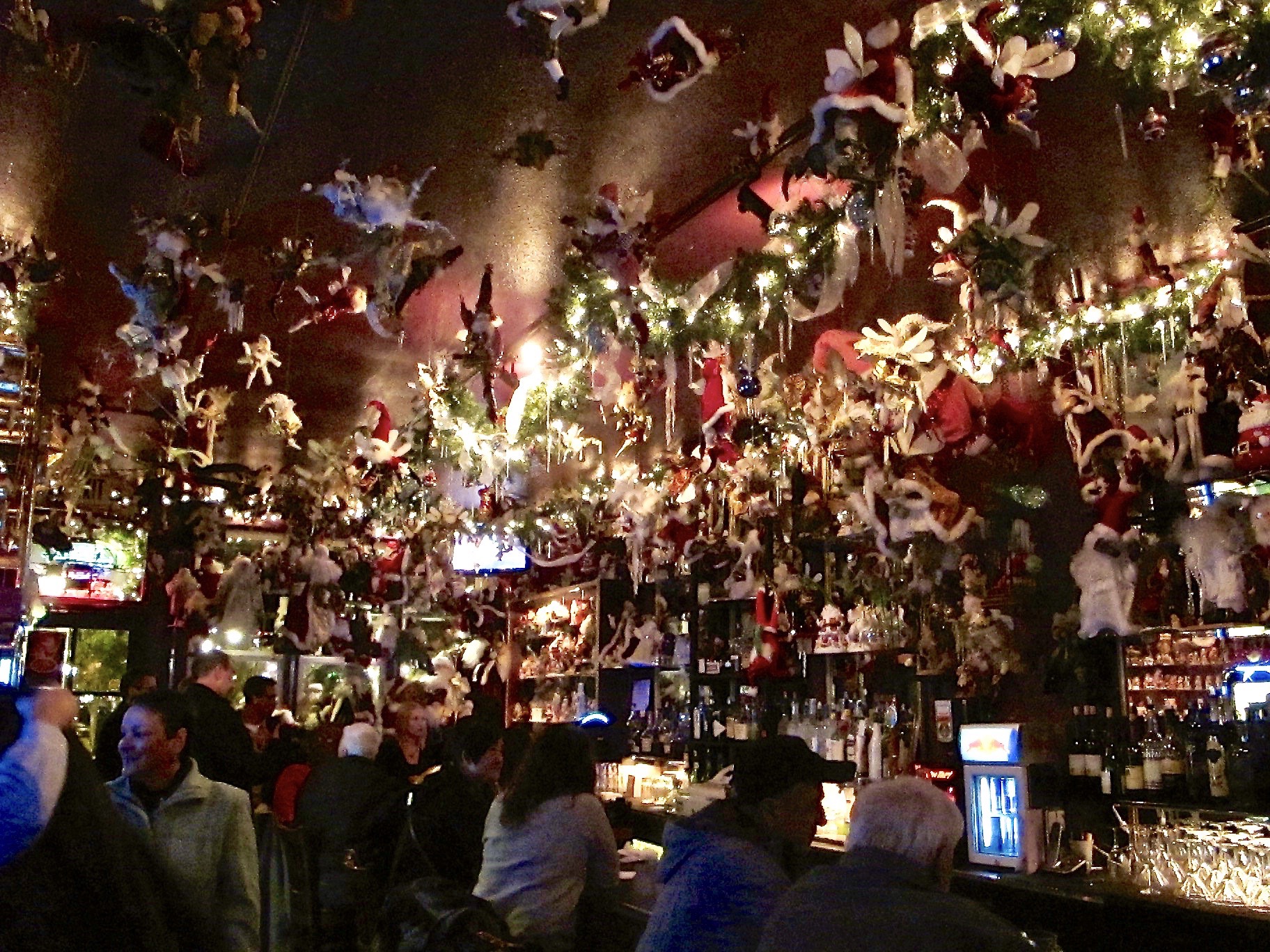
Galilea: The drag wasn’t campy, though, because Marlena was the type who wanted glitz and glamour, lots of rhinestones, gowns, big hair.
Marlena: During Christmas, we’d obviously have a lot of Christmas music. The costuming for our performances was phenomenal, too. Many people would wear Santa Claus dresses. We had a seamstress around to make clothes for us to make people into an elf or a deer or Santa or Rudolph. As for me, I’d always be Mrs. Claus, not Mr. Claus.
Bieschke: The bar became a more hipster novelty toward the end because of Christmas. I would go there and see younger people who would want to order hot toddies around the Christmas decor. Over the years, the crowd transformed a bit. A lot of people died from that earlier era. There were a lot of faces of regulars missing over the years.
Chablis: It really was like Cheers in its prime. Everybody knew your name. There is nothing like that now.
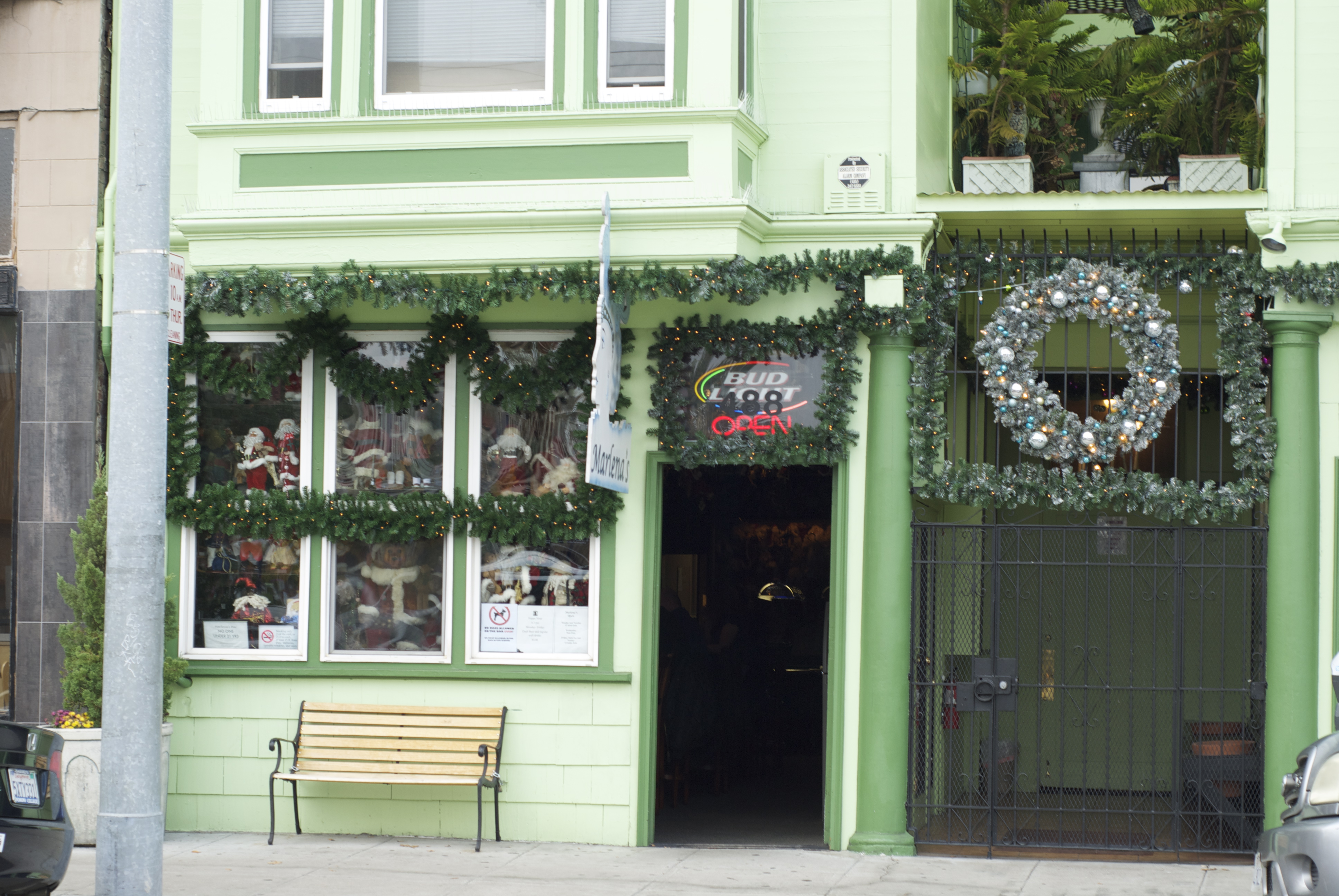
Ospital: I would best describe it as a Cheers bar for queer freaks.
Bell: Marlena’s, the feel of it, didn’t change at all over the years for me. You knew exactly what you were getting when you went to Marlena’s. It was like stepping into a bar from the 1970s each time.
Bieschke: There had been fears of Marlena’s shutting down because we were going through a period [between 2010 and 2014] where so many gay bars were closing, like Eagle and Esta Noche. It became a time when we figured, we better say goodbye to our neighborhood gay bars, because they’re going.
But Marlena wanted to sell. It didn’t close because of the usual thing like a rapacious landlord. The audience was trailing off a little bit, and Brass Tacks, which has replaced Marlena’s, is super popular among young, white yuppies. It was almost a peaceful transition of power. The community didn’t get up in arms, mostly because Marlena wanted to sell. She’s old now. We all figured that if Marlena wanted to go and she was happy, then it was time for her to go.
I would best describe it as a Cheers bar for queer freaks.
Bell: Usually, when a gay bar closes, it’s sad. With Marlena’s, I could tell Marlena just didn’t want to own a bar anymore. You can’t really stop someone from selling a bar.
Marlena: It was hard to sell, I’ll be honest with you. My business partner, Janice, wanted to sell. She owned two thirds and I owned one third. When her husband died a few years ago, I had to run it, because she had four other bars.
Galilea: Finding out the bar was closing was hard. We closed on March 3, 2013, but I found out that January.
Marlena came down to my dressing room and said, “Galee, I have something to tell you.” I asked her, “Madam, what’s wrong?” She told me we sold.
It didn’t really hit me until closing weekend. I did pretty good that last Friday. I didn’t cry. Saturday, though, I was a disaster.
We did our last show that Sunday. When I did my last show, I walked out at 11 PM and never went back. To this day, I’ve never gone back in there.
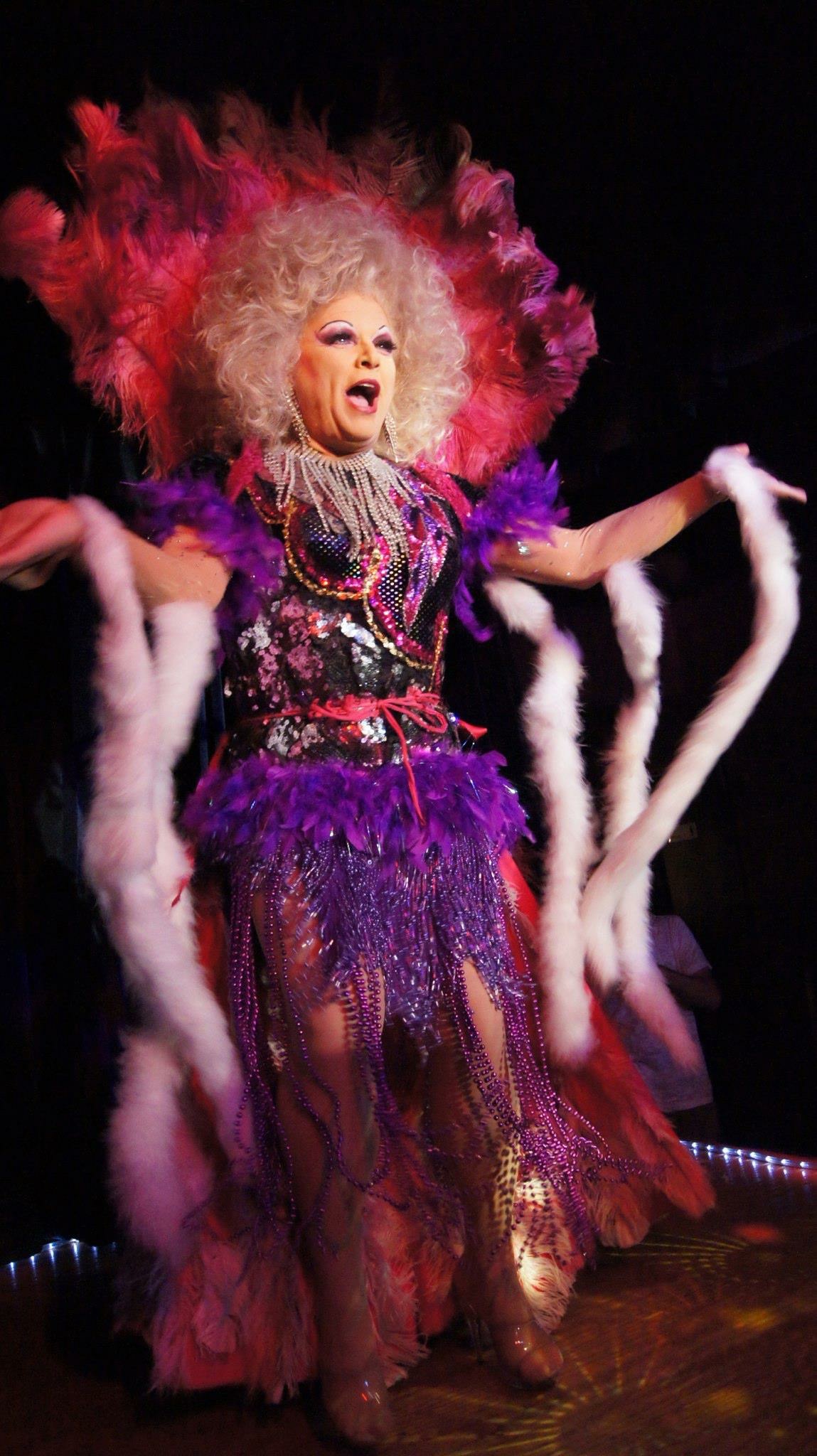
Chablis: The closing party was packed. You couldn’t move. You couldn’t even breathe.
Marlena: We did a big show that night. I had to do the “Theme from San Francisco” 15 times. The audience wouldn’t let me stop!
Chablis: “San Francisco” was Marlena’s song. Glasses were thrown against the wall and everyone was making a mess because it was the last night.
Galilea: That last show was so high and so emotional. We put Marlena in a big chair and sat her to the side of the stage where everyone could see her. People were crying happy and joyful tears.
At the end of my performance, I looked at her and said, “Good night, Marlena’s. Good night from Galee. We have just closed an era of drag in San Francisco that we’ll never see again.” I said goodnight to Marlena. Marlena looked at me and said, “Good night.” We both started crying, and I walked off. That was it.
And it’s true—we’ll never see a bar like this ever again.
Bieschke: The neighborhood lost a bit of San Francisco warmth when Marlena’s shut down. The thing I love most about San Francisco is this discovery: There are these wonderful little old-school spots in the middle of all that’s going on. I mean, who would’ve expected to see this giant drag queen behind the bar covered in Santas, with leathermen and 80-year-old drag queens bellying up to the bar while the jukebox played Johnny Cash, all in the middle of this boutique, high-tech development land?
Kauffman: I just thought, gah! when I heard it was going to become a straight bar. It was just so emblematic of what was happening to Hayes Valley. The bars that exist in the city now are just bars. They don’t feel like community spaces. They feel a little cleaned-up, more sanitized.
READ MORE: This Indian Restaurant Is Secretly a Gay Bar
Galilea: Brass Tacks is gay-friendly, but it’s basically a straight bar.
Bell: I don’t really go there. It’s just a generic straight bar to me.
Bieschke: Marlena’s was this weird, gay fairy tale that felt so San Francisco. Now, Hayes Valley is very sanitized and white.
Kauffman: A lot of that older generation did all their socializing in those bars because they were the only safe spaces. Now that’s all gone.
Chablis: It was a big loss. It had its own niche in the community, and once that niche was gone, the community dispersed. There are little drag shows all over the city now, but there is no place that has regular drag shows and gives queens a steady place to work.
Marlena’s was this weird, gay fairy tale that felt so San Francisco. Now, Hayes Valley is very sanitized and white.
Gagliardi: Every year, I like to get together with a friend or two for my holiday spirits tour, hitting up places in various San Francisco neighborhoods that go all out for the holidays, from festive decor to making superior eggnog to serving Tom & Jerry cocktails in vintage T&J cups. I still do my holiday spirits tour, but it’s not the same without a visit to the Marlena’s Santa explosion.
Ospital: The city’s gay high heel lost about an inch when Marlena’s closed down. We’re a town of new ideas and free thinkers. I always hate to see local, indigenous places close. As we move towards more of a tech-filled city, all of us, as queer people, have to figure out: Where do we get our community now?
Chablis: Even to this day, people talk about Marlena’s. The first time people came out in drag was to Marlena’s. People who met their boyfriends or girlfriends did so at Marlena’s. Everybody’s got a story about Marlena’s.
Bieschke: When you walked into Marlena’s, you felt safe. You felt as if you’d found your people. You felt like you’re part of San Francisco.
The vision I see when I walk into Marlena’s are the warm lights, whether it’s Christmas or not, and characters of all genders. They were characters who you felt that this was the only place they could be. And that was perfect.
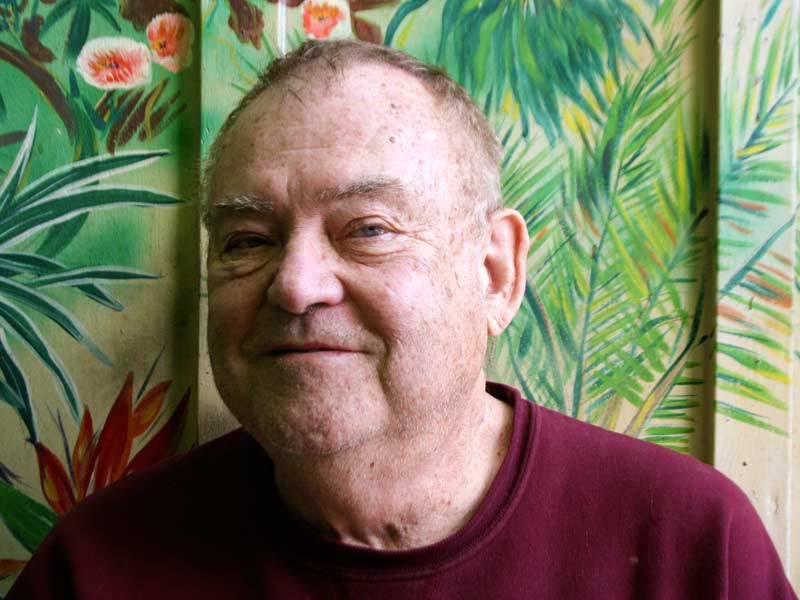
Marlena: I live right above where the bar was these days. I’ve got a roommate. I’m getting old, and I need someone around in case I fall down or something.
The first year without the bar was really very hard, but it’s easier now because my health hasn’t been as great, so there are more distractions. I just got home from the optometrist, and I think I got a little cancer in my right eye.
I miss seeing the people constantly. I just love people. I think people are wonderful. I’ve had a beautiful life in this city, but I’m not done yet.
As told to Mayukh Sen. Interviews have been edited for content and clarity.
